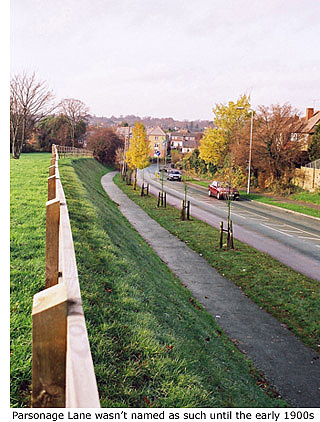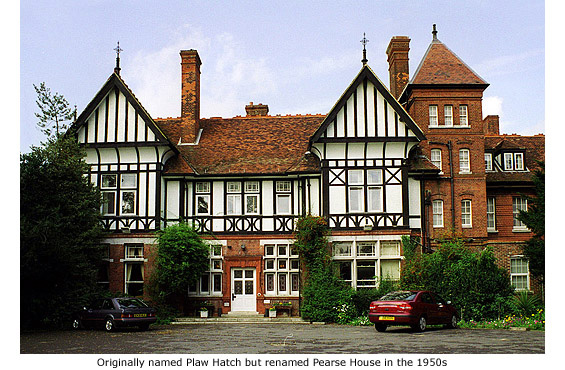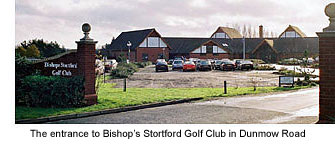|
|
|
 |
|
|
|
|
|
|
|
Parsonage Estate
|
|
 When development of the Parsonage estate began to encircle Church Manor House in the late 1950s, its garden was enclosed by a perimeter road appropriately named Church Manor. When development of the Parsonage estate began to encircle Church Manor House in the late 1950s, its garden was enclosed by a perimeter road appropriately named Church Manor.
Parsonage Lane Community Centre faces a grass recreational area, on the far side of which is the cutting that once took the Bishop’s Stortford to Braintree branch line beneath Manor Road bridge. This concrete made utilitarian structure was built by Boyd Gibbins Ltd in 1965. Most of what is left of the old track bed has since been utilised for garden extensions, or fenced off.
Prior to development of the estate this area was known as North Fields, where in the late 1940s former Stortfordian Mike McGrath spent much of his childhood. Here are his memories:
North Fields on Stansted Road where I spent many happy days damming the old stream and climbing trees, now lie under a housing estate and a small recreation ground. The path that crossed the old railway line is still there, although diverted over the 'new' bridge, but with a bit of imagination you can still make out the old track bed and until fairly recently even the path gate on the north side of the track was still there in the hedge.
The late 1940s were 'Railway children' days - much time spent hanging over the gate watching the, what even then must have been ancient engines, chugging round the bend. Your 1896 map still shows the old pond where the path from Hockerill school (my old primary) nestles next to the line. A steep sided mysterious place surrounded by trees in the 1940s - now filled in.
Cherry Gardens, where I was born and lived from 1941–1951, in those days was a bustling hive of children and families all growing veg in their gardens and keeping chickens. Open land to the north across the railway line and to the north of the path down to the Meads and into town along which I went every day to my second school at Northgate End, was a marshy place then – very spooky in the dark and misty winter early morning and evening.
In the 1800s, when Parsonage Lane was little more than a cart track, there was also here a small cricket bat factory attached to a house named Woodlands, owned by a Mr Foreman. He also owned a houseboat which he moored at Anchor Yard (See Guide 15), and used to travel the river Stort cutting willow from the banks with which to make the cricket bats. The factory was destroyed by fire early in the last century, and though the house survived the blaze it was demolished when Heathrow estate was developed in the 1950s. Many of these new houses were allocated to employees at Stansted Airport, and for that reason most of the roads are named after airports. They are: Heathrow, Prestwick Drive, Rochford Road, Manston Drive, Blackbush, Fulton Crescent, Northolt Avenue, Gatwick Close, Alconbury, Cranwell Gardens.
SEE MEMORIES PAGE, GUIDE 10
Much of Parsonage estate is built on a part of Birchanger Wood, ancient woodland over 1,000 years old and the area’s only reminder of early mans hunting forest. The nearby village of Birchanger takes its name from the wood, and in medieval times Chanters Woods and Pixsoe Wood were a part of the same forest. The name Birchanger means a birch wood on a slope.
Unfortunately, modern day Bishop’s Stortford has taken its toll on the forest, the town bypass to the north of Parsonage Lane cutting a wide swathe. To protect it from further loss and insure that no future commercial or private development ever takes place here, a consortium of local councils in Essex and Hertfordshire purchased 30 of its acres in 1976 and the remaining forty acres in 1999.
When the town’s first Secondary Modern school, sited at Causeway, closed in the early 1960s (See Guide 8), girl pupils were transferred to the newly built Margaret Dane (Girls) School at the eastern end of Parsonage Lane. The school was named in memory of one of Bishop’s Stortford’s earliest benefactors (See Guide 4 - Margaret Dane).
Though originally built as a girls only school, it became co-educational after merging with Hadham Hall school in the late 1980s (See Thorley). Greatly enlarged to accommodate the extra pupils, suggestions were asked of them for a new school name. One suggestion was Birchwood, relating it to nearby Birchanger Wood, and in 1990 the school re-opened under the new name, Birchwood High School.
|
|
|
|
Pearse House
|
|

This house originally stood at the centre of a large estate called Plaw Hatch. The origin of the name is a bit of a mystery, but as a building has stood on this site since the 16th century it must be assumed the name was derived from that time. The only evidence that remains of the original estate name is *Plaw Hatch Close, constructed as part of the Parsonage estate in the 1950s and situated behind this building.
The house that stood here previously was destroyed by fire in the 1850s, then later demolished to form the foundation of this magnificent Victorian building. With its Mock Elizabethan facade it looks no different now to when first built as a family home in 1870, though who the original owner was is unknown.
However, the first recorded occupier was one Frederick William Blunt who purchased the property in 1877 and lived in it until 1890. The next occupier was Mrs Fanny Rowley Smith. She lived here until her death in 1900, at which time it was bought by Sir Walter Gilbey who never lived here. He sold it the following year to Charles John Hegan, and he sold it in 1919 to Selwyn Robert Prior. He held the property until 1936 when it was bought and occupied by Dr Henrietta Treithick. She donated the house to the war effort in 1939.
During this period the property became an annexe to the nearby Herts and Essex Hospital, its cellars converted for use as an air raid shelter. Towards the end of the war it was used as an officers' mess by USAF 344th Bombardment Group stationed at Stansted, and in 1946 was acquired by Herts and Essex High School for use as a boarding house (See Guide 12 - Warwick Road).
Thirty boarders aged between 11 and 19 were accommodated in this former residential property, complete with comfortable furnishings and enviable views across open countryside from each and every window. The prospectus given to parents wanting their daughters to be educated at the school described it as a place where girls could ‘show they had initiative, individuality and a willingness to take responsibility’. After the retirement of the school’s headmistress, Miss Pearse, the house was renamed Pearse House in her honour.
The school ceased to take in boarders from July 1966, at which time Pearse House was taken over by the Education Committee of Hertfordshire and run as a residential centre for county, junior and middle schools. When their tenancy ended in 1977 it was acquired by the current owner, P.H. Levy. Since that time Pearse House has become a successful management training and conference centre, as well as a reception centre for private functions and special occasions. It was one of the first venues in the country to offer civil wedding ceremonies conducted by registrars.
*Plaw Hatch Close is also the site of Summercroft school, which takes its name from an earlier field name in the area, as shown on an 1870s map.
|
|
|
|
Dunmow Road
|
|
At this point Parsonage Lane intersects Dunmow Road; the way to the left leading to the Essex/Hertfordshire county line, which is also Bishop’s Stortford’s eastern boundary. During the 1980s and 90s, land development in this area saw the building of Woodside Park light industrial estate; a new football stadium and new club-house for Bishop’s Stortford Golf Club. Before the nearby A120 Bishop’s Stortford bypass was opened in the 1970s, Dunmow Road and Parsonage Lane were the only two routes into the town when approached from the east.
|
|
|
|
Bishop's Stortford Golf Club
|
|
 Situated some 300 ft (100m) above sea level and covering approximately 160 acres, Bishop’s Stortford’s original golf course cost £20,000 to build and was part of Sir Walter Gilbey’s ‘master plan’ for Hockerill Park Estate (See Guide 12). Advice on course design came from James Braid of Scotland and it was formerly opened on 11 June 1910 with an exhibition match played between James Braid and Amauld Massey (the Open champion from France) versus Harry Vardon and J. H. Taylor of England. The prize was £100. Situated some 300 ft (100m) above sea level and covering approximately 160 acres, Bishop’s Stortford’s original golf course cost £20,000 to build and was part of Sir Walter Gilbey’s ‘master plan’ for Hockerill Park Estate (See Guide 12). Advice on course design came from James Braid of Scotland and it was formerly opened on 11 June 1910 with an exhibition match played between James Braid and Amauld Massey (the Open champion from France) versus Harry Vardon and J. H. Taylor of England. The prize was £100.
Sir Walter Gilbey’s ill health at the time led to his son, Tresham, being appointed to the club’s management committee, and its first President was the Earl of Warwick. Some 300 members, including ladies, paid subscription fees of 5 guineas (£5. 25p) and 3 guineas (£3.15p) respectively.
At the start of the Second World War, four of the course’s eighteen holes were given over to the plough to help with the war effort, but the course was rearranged in 1953 and eighteen holes reinstated. However, little could be done about the Bishop's Stortford to Braintree branch line that passed through the middle of the links, and up until the late 1960s golfers had to negotiate the track via a wooden footbridge.
Difficult times between the wars forced the Gilbeys' to relinquish control of the club, and through the years different groups of shareholders took over the management. Finally, in 1993, club members secured the course in perpetuity and embarked on an ambitious plan. Land that included the original verandad club-house and course entrance further along Dunmow Road (next to the Nags Head public house) was sold for housing development, and a new club-house with modern facilities built here.
From its very beginnings the course became a firm favourite with golfers from the Houses of Parliament, a connection still maintained with an annual match played between club members and the Parliamentarians Golf Society. Regular charity matches are also held, attended by both professional golfers and well known celebrities.
In its long history a number of outstanding players have emerged from the club, perhaps the most famous being Guy Hunt who played in Ryder Cup and World Cup teams, and eventually went on to win the Dunlop Masters in 1977. www.bsgc.co.uk
|
|
|
|
|
|
[ BACK TO TOP ] |
|
|
|
|
|
|
|
|
|




 Situated some 300 ft (100m) above sea level and covering approximately 160 acres, Bishop’s Stortford’s original golf course cost £20,000 to build and was part of Sir Walter Gilbey’s ‘master plan’ for Hockerill Park Estate (See Guide 12). Advice on course design came from James Braid of Scotland and it was formerly opened on 11 June 1910 with an exhibition match played between James Braid and Amauld Massey (the Open champion from France) versus Harry Vardon and J. H. Taylor of England. The prize was £100.
Situated some 300 ft (100m) above sea level and covering approximately 160 acres, Bishop’s Stortford’s original golf course cost £20,000 to build and was part of Sir Walter Gilbey’s ‘master plan’ for Hockerill Park Estate (See Guide 12). Advice on course design came from James Braid of Scotland and it was formerly opened on 11 June 1910 with an exhibition match played between James Braid and Amauld Massey (the Open champion from France) versus Harry Vardon and J. H. Taylor of England. The prize was £100.